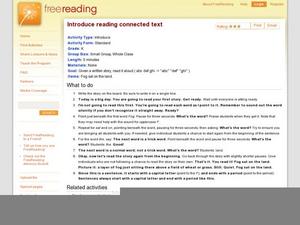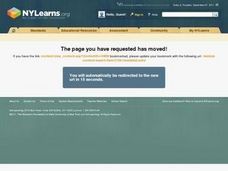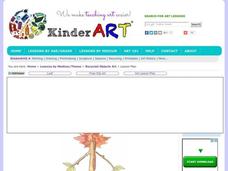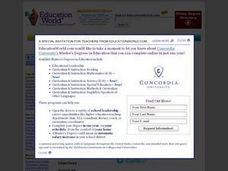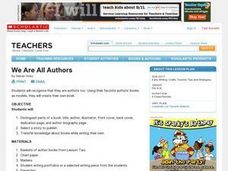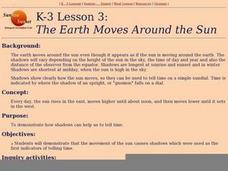Curated OER
Wynton's Tune
Students examine the serigraph, "Wynton's Tune," by artist Faith Ringgold. They discuss the painting, listen to jazz music, create a drawing that tells a story inspired by their favorite music, and write sentences describing their artwork.
Curated OER
Boxes & Blocks: Tunnel Vision
Students paint, create, and crawl through their own tunnel. For this early childhood visual arts lesson, students will develop gross motor skills and engage in activities that promote physical exercise as they create and explore tunnels...
Curated OER
Yummy Gummy Subtraction
Students practice subtraction facts using gummy bears. In this subtraction lesson, students use the gummy bears as a manipulative to solve simple subtraction facts.
Curated OER
The Three Little Pigs
Kindergarteners are presented with three types of materials: real straw, sticks, and a real brick and make prior knowledge connections as it relates to the story of The Three Little Pigs. They listen to the story and work together to...
Curated OER
Where We Live
Who has the most? Young learners practice charting data using familiar information. They help fill out a classroom chart by recording the number of people, pets, televisions, etc. in their home. Guiding questions help them investigate...
Curated OER
Introduce Reading Connected Text
Get your scholars ready to read their first story...with a little assistance, of course. Projecting the short story (included) for all readers to see, point to each word so they can sound it out together. The strategy here is not to have...
Curated OER
Guidance for Creating Writing Lessons for Dyslexic Students
How do you help a child with dyslexia succeed as a writer? Here is a resource for those who need guidance in creating writing lessons for their learners with dyslexia. It discusses research-based strategies that can be used and...
Curated OER
Acrylic "Shingles"
Young artists of all ages create texture using dried slabs of pourable acrylic paint. They experiment with texture by turning a liquid into a solid and finally into a 3-D work of art. This instructional activity uses easy-to-find...
Curated OER
Clowing Around: Ceramics
Clowns are a big hit with kids! Explore a few circus related websites to get an idea of how clowns look and what they do. They then build sculpting skills by creating expressive clown faces out of clay. Web links, materials list, and...
Curated OER
Picture Books and the Bill of Rights
Students identify the basic freedoms of citizens in the United States. In this Bill of Rights lesson plan, students act out scenarios about the Bill of Rights. Students create a picture book describing the rights they've...
Perkins School for the Blind
Left Versus Right
When you can't see, it is extremely important to be able to reorient yourself. Learners with visual impairments work though an activity to build spacial awareness based on moving left and right. A marker (bracelet, bell, or weight) is...
Perkins School for the Blind
Taking Turns
For small children or learners with disabilities, learning to wait patiently and taking turns is very important. In pairs, two children with visual impairments take turns asking for, waiting for, and playing with a musical...
Perkins School for the Blind
Build a Word
Get out those scrabble tiles and a braille tape labeler because today we are playing a build-a-word game! Label several sets of scrabble tiles using the braille labeler, place them in a box, and have children take turns pulling letter...
California Academy of Science
Notice and Wonder
Pint-sized zoologists practice the art of observation. They take notes, pictures or written, as they observe an animal for a period of time. This can be done at the zoo, with a visiting classroom animal, or perhaps at the humane society....
Curated OER
Paper Plate Sunflowers
A great way to recall the parts of a flower is to make one. Little learners create sunflowers out of paint and paper plates. They also discuss and label the various parts of their flowers.
Curated OER
Investigation - Snack TIme
Students explore solving addition and subtraction problems. They solve real life problems. Students participate in a simulation activity to find the missing addend. They demonstrate adding and subtracting whole numbers.
Curated OER
Leaf People
Kids create leaf people out of sticks, glue, and leaves. They use their imagination to construct leaf people and then glue them onto construction paper. Tip: Extend this craft by incorporating writing. Have learners write a short story...
Curated OER
Signs of Spring Door Hanging
Students create their own original design for a spring door decoration. As a class, they follow specific instructions to make the decorate the door piece. They also practice using art supplies and materials correctly and complete a...
Curated OER
Water Changes and Moves
Students explore the three forms of water and observe how it changes from a solid to a liquid to a gas. The concepts of condensation, evaporation and the introduction to the water cycle form the basis of this lesson.
Curated OER
We Are All Authors
Students analyze the components of a book to use it as a model for the creation of their own book. The title, author, illustrator, front cover, back cover, dedication page, and author are examined in this instructional activity.
Curated OER
Storytelling in the Classroom
What makes story telling special? Young readers demonstrate how to tell a story to others. Kindergarteners, first graders, and second graders read biographies of "Building Blocks" characters and tell a story about a character to their...
Curated OER
Garden In a Glove
Students investigate the concept of seeds and how they can germinate. They obtain seeds and isolate them in a rubber glove before transplanting them into the ground. The lesson plan includes a graphic organizer for observations or...
Curated OER
The Earth Moves Around the Sun
Students demonstrate that the movement of the sun causes shadows which were used as the first indicators of telling time.
Curated OER
The American Revolution: A Play
No lesson accompanies this drama about the American Revolution. With 13 speaking roles, the short script could be used for a class production, a lesson on the parts of a play, or to supplement your social studies curriculum.





